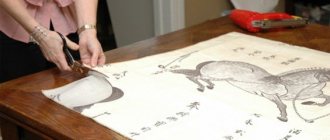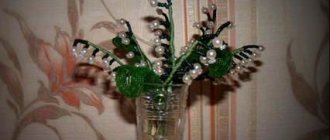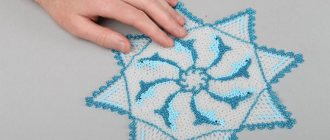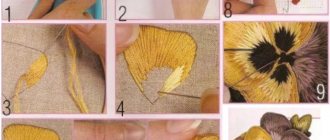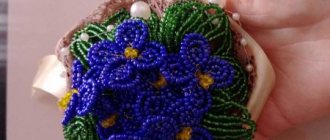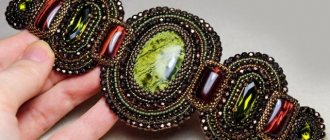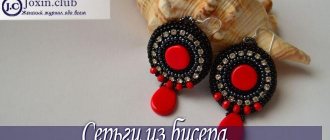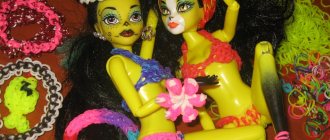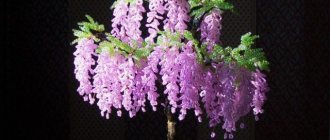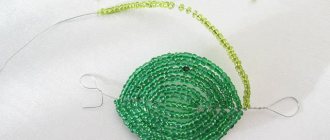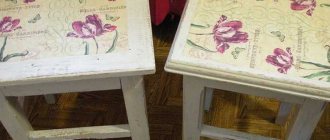Rating: 4.95/5 (39)
Today, bead weaving is not only an interesting and exciting activity, but also a way to earn extra money. In order to start earning money, you need to get the hang of working with these small beads. The best way to practice is to make small animal figures from beads , and we will show you weaving patterns for beginners. And even if you don’t succeed the first time, your children will still be delighted.
Types of beads
- Plastic beads. The most inexpensive. Ideal for beginners and children's creativity. It is rarely used by professional craftswomen due to its not very remarkable decorative properties. Simply put, he's not very handsome. But these beads are the lightest, so it’s good to make figures for a backpack or something like that from it.
- Glass beads. Available in different sizes. Moreover, the larger the number in the size number, the smaller the beads themselves. The main shapes are round, square, tube-shaped (glass tier).
- Faceted beads. Has one or more faceted sides. Nowadays only faceted beads from Japanese manufacturers are on sale; previously they were produced in France and the Czech Republic. Craftswomen value such beads for their unsurpassed shine.
- Delica beads (DELICA). Very high quality Japanese beads. All the beads are as chosen, smooth, in the shape of tiny cylinders. The color range includes 600 shades. The best option for dense embroidery. The only negative is the high price of Delica.
- There are also various unusual beads - butterfly-shaped, droplet-shaped, two-hole, tile-shaped, cubic, triangular and even hexagonal. But all this is no longer for beginners, but for experienced bead weavers.
There are also transparent and opaque beads, with a silver-plated hole, changing color in the sun, mother-of-pearl and others.
How to choose beads depends on what exactly you will weave from them. Usually the type of beads is indicated in the description of the pattern. More experienced craftsmen select the necessary beads themselves when they begin to understand the effect they create.
Calibration
It is interesting that in one batch of uncalibrated beads (and these are much cheaper) there will be beads of different sizes. You need to calibrate them yourself. Beads are calibrated at home in a variety of ways, from sifting through cans with cells of different diameters to simply shaking in a cup - then large beads will rise to the top, and small ones will go to the bottom.
However, you can buy not cheap, but rather expensive (but high-quality) Japanese or Czech beads and not worry - they will definitely all be the same size. Well, for all kinds of rubber baubles, different-sized beads are quite suitable, this way the product will even look more interesting.
Beading Tools
Threads, fishing line, wire
In addition to the beads themselves, you will definitely need something to string them on. Fishing line is most often used - it is quite strong, very inexpensive, and lightweight. In addition to fishing line, thin wire or thread .
Threads for beading : when choosing them you should take special care. If the diagram does not indicate exactly which threads to use, use the following data:
- Regular cotton threads break easily, which can ruin a half-made or even almost completely finished product. Therefore, it is better to completely abandon bobbin threads.
- Nylon threads for beading are durable and will not break. But it is very difficult to knit from them - they stubbornly unravel, also threatening to nullify all your work.
- Silk threads do not have the disadvantages of the two options described above. But their cost is prohibitive.
- Among the inexpensive and quite convenient options for beading, you can also name rubber threads. True, you need to adapt to them. But they make excellent hair ties and wrist bracelets.
Beading wire : choose soft and thin wire. The ideal option is copper wire for beading. Before buying, check its strength - it should not tear too easily. That is, we don’t take the thinnest one of all those presented on the counter. A skein usually contains 100 meters of wire.
Beading line is ideal if you need three-dimensional figures - crocodiles, men and other crafts similar in outline to the original. The fishing line allows you to give the composition the required rigidity without sacrificing elasticity. Therefore, flowers, petals, etc. are also woven from it. You need to choose a thin and strong fishing line. But beginners should practice on a slightly thicker fishing line.
Advice . When choosing fishing line, wire or thread, select them for a specific bead, since each of these materials must be threaded into the hole at least 2, and preferably 3 times. That is, the diameter of the hole in the beads should be three times larger than the thickness of the purchased base.
Various plants made of beads and wire for interior decoration and other products
It’s easy to figure out what can be woven from beads and wire if you choose the right patterns. Typically, flower buds and tree leaves are made on this basis.
The features of creating petals are determined by the scheme. Most often, parts of a flower are woven like a canvas. Weaving in circles is used, when first a small circle is made, then a larger one in diameter. The first element is nested within the larger one. Next, the circles are enlarged.
When weaving leaves for trees, the ideal option to create is the “Cross” pattern. More voluminous compositions are formed using ovals and circles, which are very simply made from beads and hold their shape thanks to wire.
Source: fb.ru
photo
Beading technique
There are four main techniques.
- Weaving using just one thread (fishing line, wire)
- Weaving with two threads at the same time (in fact, simultaneously working with both ends of one thread).
- Parallel weaving, when beads are strung simultaneously from both ends, and the thread is threaded through the beads not just once, but several times. This is a slightly more complicated option that allows you to create more complex figures.
As a result, we get this beaded necklace:
- Mosaic weaving. Beautiful technique of dense bead weaving.
Using this technique you can weave something like this:
Dragonfly
The dragonfly will also be easy to make. You can make the wings in the form of loops or use the brick weaving technique with transparent beads.
To make a simple dragonfly from beads:
- beads for wings (76 pcs.);
- beads for the body (51 pcs.);
- beads for eyes (2 pcs.);
- thin wire (50-60 cm);
- scissors;
- weaving pattern for beginners.
You can watch the process of making a dragonfly more clearly in the video:
Beading patterns for beginners
Let's take the simplest beading patterns for beginners.
How to weave a bracelet from beads
Bead chain diagram
Beaded butterfly: diagram
You will need wire and beads of four colors in three sizes - 2, 3 and 4 mm.
Beaded keychain diagram
The most popular weaving options
There are several basic weaving options that are basic and are used very often. Based on such motifs, you can create any product, depending on the desire of the needlewoman and what can be woven from beads. You can focus on the list of basic patterns:
- A continuous fabric that is woven bead into bead.
- A cross, where 2 beads are placed at opposite ends of the fishing line, and then connected with one bead.
- Connecting several strips into one piece. Beads are strung onto separate pieces of wire, fishing line or thread, and then these parts are joined at the edges into one element.
The technique for performing such motifs can be different. There are also more complex weaving options that only experienced craftswomen can do.
Beaded brooch master class
The finished product will look like this:
To make such a brooch, you will need:
- Plastic beads in three colors: pink, white and green.
- Core (cabochon)
- Bead needle
- fishing line
Progress:
- We string 36 beads onto a fishing line. We form a ring out of them and tie the fishing line into a knot. Using mosaic weaving, we knit five more rows of white beads, and the sixth row of pink beads. It will turn out like this:
- In the seventh row, three pink beads are added through each white one. We tighten everything with fishing line.
- Place the prepared core in the center of the brooch.
- We also weave the reverse side of the product using mosaic weaving, gradually reducing the number of beads.
- We weave green petals as follows:
We alternate a small and a large sheet, made according to the following scheme:
- We weave the leaves into a brooch.
What exactly can be made from beads and fishing line?
A standard set of materials does not always mean simple work. Many beginning needlewomen think that only flat products can be made from beads and fishing line. Trivial ones are: bracelets, earrings, flat keychains, canvases for further decoration. Additional options regarding what can be woven from beads and fishing line:
- Brooches and stripes in which beads can be successfully combined with larger beads and glass stones.
- It is possible to make three-dimensional figures, since a well-tightened fishing line and a correctly selected pattern are an option for making such elements.
- Using beads and fishing line you can embroider a beautiful picture. The same principle can be used to decorate clothes.
- False collars, ties and bows can be easily recreated using beads and fishing line.
The list can be continued endlessly. The correct manufacturing principle can help in working on a creation.
